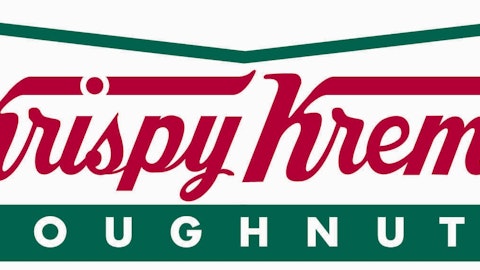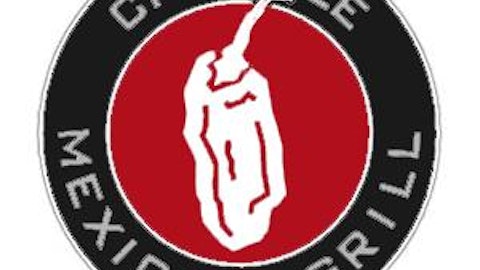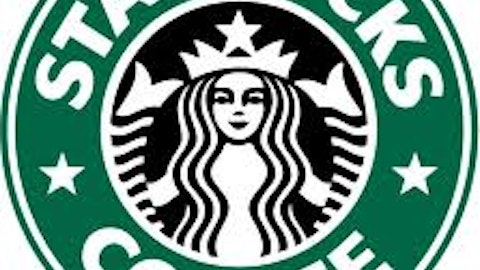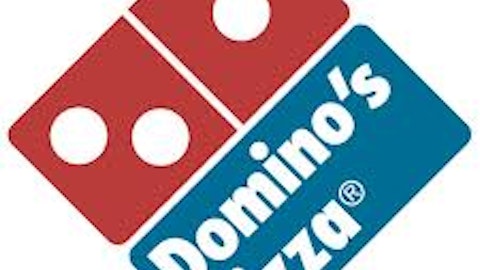Over the past two years, earnings season has meant only one thing for Krispy Kreme Doughnuts (NYSE:KKD) shareholders — a chance to see their stock advance by double digits. Last night, the market reasserted that the only thing that’s certain is that there are no certainties when it comes to investing.

Source: Mark Lee, Flickr.
Krispy Kreme Doughnuts (NYSE:KKD) shares dove after the company announced second-quarter results that showed a comparable-store sales increase of 10% as adjusted income jumped 17% to $9.6 million, or $0.14 per share. Unfortunately for current shareholders, while revenue of $112.7 million was enough to skirt by estimates, Krispy Kreme’s EPS fell $0.02 shy of expectations, even with the company sticking to its full-year EPS forecast of $0.59 to $0.63.
But are things really as bad as the dip implies? Let’s have a look…
Same-store sales growth is phenomenal
The first thing that stands out to me is that foot traffic was the primary driver of same-store sales growth. There is nothing more an investor in Krispy Kreme Doughnuts (NYSE:KKD) loves to see than increasing foot traffic. Customer loyalty and the ability to pass along price hikes all starts with increasing foot traffic and not the other way around, so this would signal to me that Krispy Kreme’s push into new markets and in expanding its menu is paying off.

Source: Samantha Celera, Flickr.
If you recall, one of the primary products I’ve homed in on for restaurants in terms of driving recurring customer traffic is branded coffee. It seems so simple, but exclusive coffee lines draw in customers with relatively little cost and keep them hooked. Panera Bread has been incredibly successful at this thanks to a partnership with Gavina Gourmet Coffee, which, amazingly enough, also has an exclusive blend partnership with McDonald’s. By offering right-sized portions complete with branded coffee blends, Panera is able to deliver unique products to its customer base.
Another factor that Krispy Kreme Doughnuts (NYSE:KKD) didn’t really get into all that much but I suspect has to be working well is its push toward healthier food options. Starbucks recently revamped its in-case snacks and sandwich options to come from relative local suppliers that use only natural and organic ingredients. While these are more expensive, the perception among consumers is that they’re getting a product that’s more nutritious for them.
Krispy Kreme Doughnuts (NYSE:KKD) has been doing something similar with the introduction of yogurt, oatmeal, and fruit juice to its menu. Don’t worry, you’ll always be able to get your favorite jelly-filled doughnut covered in a chocolate glaze at Krispy Kreme, but with public awareness of obesity increasing, Krispy Kreme has been masterful in its understanding that it needs to (and is smart to) cater to a wider audience.
Geographic diversity is helping
It’s an often overlooked fact, but with Dunkin Brands Group Inc (NASDAQ:DNKN)‘ Dunkin’ Donuts primarily on the East Coast and Krispy Kreme on the West Coast, the two have been left to their own devices. That could be changing, with Dunkin Brands Group Inc (NASDAQ:DNKN)’ Donuts planning to make another push into California, but it shouldn’t represent too much of a concern for Krispy Kreme shareholders.
What stands out among Krispy Kreme’s report with regard to geographic diversity is that international revenue growth is good, not great, and that costs to open new stores are running a bit higher than anyone expected.
We all know it costs money to expand into new markets, so investors shouldn’t be all that concerned that direct operating expenses jumped to $93.8 million from $85.7 million. What might be a very minor yellow flag is that Krispy Kreme still doesn’t fully understand the nuances of different cultures’ buying habits yet. The company noted, for example, how a change in holiday observance affected its revenue results and how warmer weather hampered sales in the U.K. I don’t feel this is particularly bad news so much as it represents the typical growing pains a predominantly domestic company will encounter when pushing overseas.
So what’s the problem?
“If domestic growth is strong and international growth is OK, then what’s the problem?” you might be asking. The answer is simply that investors’ emotions have gotten out of hand.
Investors are notorious for pushing share prices far too low when times are bad and overestimating a company’s market value when times are good. This appears to be another case in which shareholders took a few of the carrots that Krispy Kreme dangled and ran too far with them.
Over the past few months Krispy Kreme has rewarded shareholders by retiring $22 million in debt and announcing a $50 million share repurchase program.Both announcements are good news for shareholders; don’t get me wrong. However, share repurchase programs that are announced when a stock is very near a 52-week high rarely translate into good value for shareholders, historically speaking. In fact, share repurchases can often hide the fact that near-term growth is expected to slow by helping to reduce the amount of shares outstanding and boosting EPS.
Shareholders appear to have been expecting the cow from Krispy Kreme this quarter and are disappointed to have only been brought the milk instead. Does this mean Krispy Kreme failed to live up to its own growth forecasts? On the contrary, Krispy Kreme is executing exactly as it said it would. The only factor that didn’t meet spec this quarter was investors’ lofty expectations.
What’s next for Krispy Kreme?
Following its report, Krispy Kreme will continue to focus on domestic and international expansion. I feel it will become increasingly difficult for Krispy Kreme to be able to grow its same-store sales figures by double digits even with the introduction of new products and expansion into untapped markets. Realistically, I look at Krispy Kreme’s projected P/E in fiscal 2014 of 37 (assuming the high end of its forecast, $0.63) as compared to its full-year sales growth forecast of roughly 8% and am a bit concerned that emotions are getting the better of investors.
I fully understand the notion of wanting Krispy Kreme to succeed as an investment, and all signs have pointed to a sustained turnaround, but the valuation simply doesn’t match what Krispy Kreme is fundamentally able to bring to the table. Until sales growth improves, costs decline, or profits are pumped up, I feel shareholders could be in line for more bouts of “buy the rumor, sell the news” come earnings time for the foreseeable future.
The article Investors Find a Hole in This Doughnut originally appeared on Fool.com and is written by Sean Williams.
Fool contributor Sean Williams has no material interest in any companies mentioned in this article. You can follow him on CAPS under the screen name TMFUltraLong, track every pick he makes under the screen name TrackUltraLong, and check him out on Twitter, where he goes by the handle @TMFUltraLong.The Motley Fool owns shares of, and recommends, McDonald’s, Panera Bread, and Starbucks.
Copyright © 1995 – 2013 The Motley Fool, LLC. All rights reserved. The Motley Fool has a disclosure policy.




